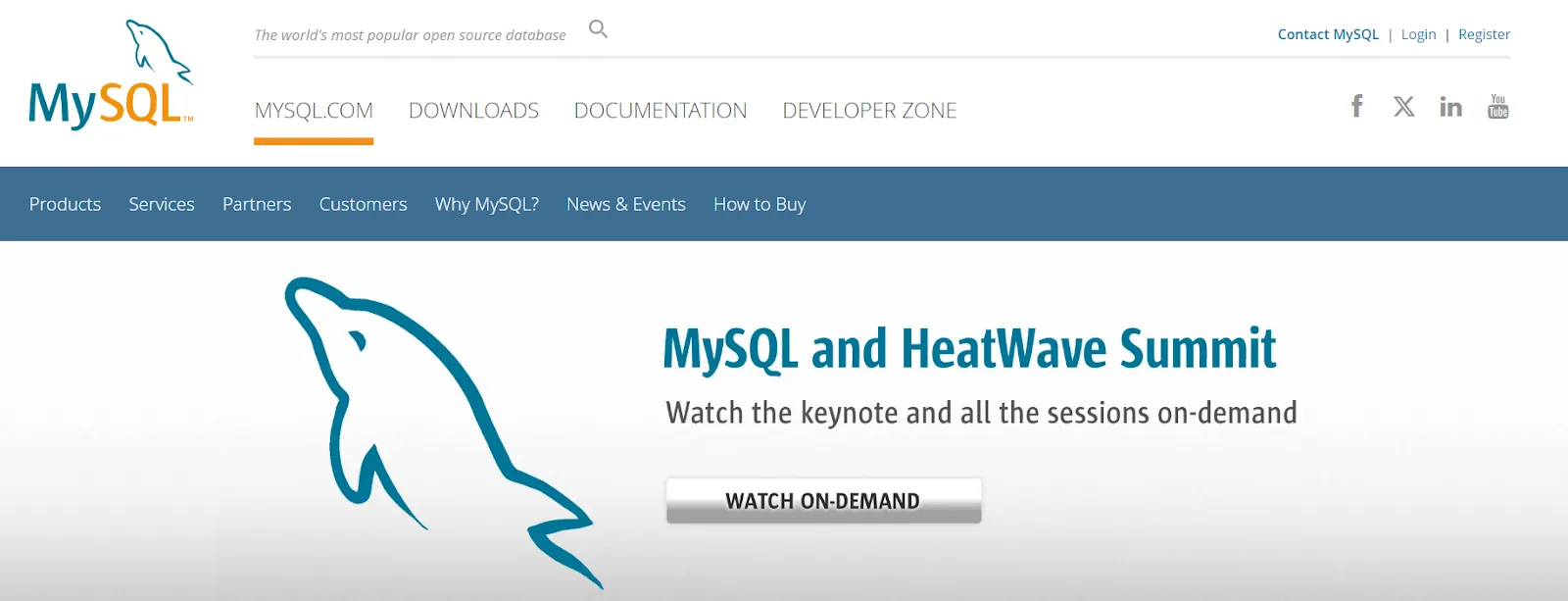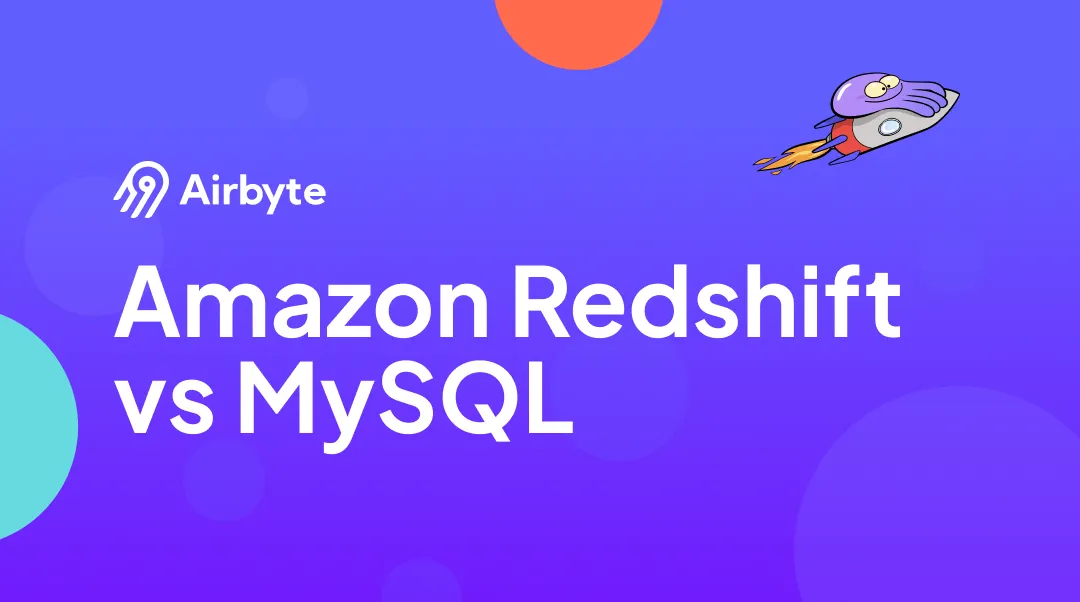Amazon Redshift vs MySQL- A Comparative Analysis
Summarize this article with:
✨ AI Generated Summary
Amazon Redshift is a cloud-based, columnar data warehouse optimized for large-scale analytics, offering features like automatic scaling, federated queries, and machine learning integration. MySQL is an open-source, row-oriented relational database ideal for transactional processing with ACID compliance and extensive ecosystem support.
- Redshift suits big data analytics, business intelligence, and ML workloads with massive parallel processing and serverless options.
- MySQL excels in operational applications, web back-ends, and smaller datasets requiring real-time consistency and flexible deployment.
- Redshift scales horizontally with pay-as-you-go pricing; MySQL primarily scales vertically and is free with optional enterprise editions.
- Both can be integrated using tools like Airbyte for streamlined data migration and synchronization.
One of the biggest concerns for a data-driven organization is handling data effectively. Therefore, choosing the right database is crucial for efficient data management. However, with many options, it can be challenging to find the right tool for your use case.
Two of the most popular storage systems organizations use are Amazon Redshift and MySQL. While they both serve to store your data, there are huge differences between their use cases and functionalities. In this article, you will learn about both tools in detail, including their overview, key features, and differences.
What Is Amazon Redshift and How Does It Work?

Created in 2012 by Amazon Web Services, Redshift is a leading cloud-based data-warehouse solution. The platform is designed to operate in a serverless architecture to handle analytical workloads. Redshift is a column-based storage system that allows you to store large amounts of data efficiently in a centralized repository.
In addition, Redshift shines in its ability to handle large-scale data in structured and semi-structured formats. This includes CSV, JSON, and the Avro file format.
Amazon Redshift operates as a massively parallel processing data warehouse that distributes both data and query processing across multiple compute nodes. The platform's distributed computing model enables it to handle large-scale data warehousing requirements while maintaining query performance through parallel processing. This architecture proves particularly effective for business intelligence applications, data science initiatives, and analytical workloads that benefit from columnar storage and parallel query execution.
The platform offers multiple deployment options to meet diverse organizational needs. Amazon Redshift Serverless provides automatic scaling capabilities that adjust capacity across multiple dimensions including concurrency, data volume, and query complexity. This serverless approach eliminates the need for capacity planning and manual resource management while optimizing costs based on actual usage patterns.
Key Features of Redshift
- Petabyte-Scale Warehouse – automated managed storage that supports large compressed data workloads
- Federated Queries – query live data across different Amazon RDS platforms, including Aurora PostgreSQL and MySQL, without data migration
- Zero-ETL Integrations – fully managed solutions that make transactional and operational data available from multiple sources including Amazon Aurora, RDS variants, DynamoDB, and enterprise applications like Salesforce and SAP
- Concurrency Scaling – automatically adds processing power to handle thousands of concurrent users while maintaining consistent query performance
- Machine Learning Integration – enables data analysts to create, train, and apply ML models using familiar SQL commands through integration with Amazon SageMaker
What Is MySQL and What Are Its Core Capabilities?

Created in 1995 by the Swedish company MySQL AB, MySQL is a widely popular relational database-management system (RDBMS). It stores data in relational tables composed of rows and columns. Using Structured Query Language (SQL), you can query, define, and manipulate data.
Part of the well-known LAMP stack (Linux, Apache, MySQL, PHP), MySQL is used in web applications, native applications, and other services. It runs on all major platforms including Unix-based systems, Windows, and macOS. Major users include Airbnb, Pinterest, Shopify, and Uber.
MySQL's row-oriented, ACID-compliant architecture excels in transactional processing environments where data consistency, transaction integrity, and real-time processing capabilities are paramount. The platform's mature ecosystem, extensive tooling support, and flexible deployment options make it particularly suitable for operational applications, content management systems, and applications requiring frequent data modifications with immediate consistency requirements.
The database system supports multiple storage engines, with InnoDB being the default engine that provides ACID compliance, foreign key support, and crash recovery capabilities. This storage engine framework allows you to choose engines such as MyISAM or InnoDB to optimize for specific workloads, providing flexibility in balancing performance characteristics with durability requirements.
Key Features of MySQL
- Open Source – no licensing cost and strong community support
- ACID Compliance – guarantees atomicity, consistency, isolation, and durability for reliable transactions
- Multi-Storage Engine Support – choose from various storage engines including InnoDB, MyISAM, and others to optimize for specific workload requirements
- Extensive Ecosystem Integration – comprehensive support for multiple programming languages through official connectors including JDBC, ODBC, and language-specific drivers
- High Availability Features – replication capabilities, clustering support, and backup solutions for enterprise reliability requirements
What Are the Key Differences Between Amazon Redshift and MySQL?
The main difference between Redshift and MySQL is that Redshift is a cloud-based data warehouse optimized for large-scale analytics and high-performance querying, whereas MySQL is a relational database designed for transactional processing and smaller-scale applications.
The architectural differences between these platforms fundamentally determine their optimal use cases and performance characteristics in enterprise environments. Amazon Redshift's columnar, massively parallel processing architecture provides significant advantages for analytical workloads that require complex aggregations, joins across large datasets, and extensive data analysis capabilities.
MySQL's row-oriented storage and ACID compliance optimize it for transactional workloads where data consistency, transaction integrity, and real-time processing capabilities are essential.
How Do Amazon Redshift and MySQL Compare in Technical Architecture?
Key Components
Redshift
- Cluster – a set of nodes (one leader node plus compute nodes) that stores data
- Nodes – store data and execute queries in parallel; their number affects performance and capacity
- Compute Nodes – each node is further partitioned into slices with dedicated memory and disk allocation, enabling fine-grained parallelism
- Leader Node – coordinates parallel execution across compute nodes, managing query planning and result aggregation
MySQL
- Table – collection of related data within rows and columns
- Primary Key – unique identifier for every row
- Storage Engines – pluggable components like InnoDB and MyISAM that determine how data is stored and retrieved
- Buffer Pool – primary cache for data and indexes
Architecture Differences
Redshift uses a distributed architecture in which data is spread across several nodes. A leader node coordinates query execution, and compute nodes store data and process queries in parallel. Data is stored in columnar format, improving performance and reducing storage needs.
MySQL employs a single-server, client-server model where a MySQL server accepts connections from multiple clients and processes their queries. Its storage-engine framework lets you choose engines such as MyISAM or InnoDB to optimize for specific workloads.
Scalability Approaches
Redshift is designed for horizontal scaling where you add nodes as data volume or query complexity grows. Massive parallel processing automatically distributes data and queries across nodes for high performance.
MySQL primarily supports vertical scaling through upgrading a single server. It is ideal for small-to-intermediate datasets but can struggle with large-scale processing. Horizontal scaling is possible via replication, sharding, and third-party tools, but requires significant manual effort.
Pricing Models
Redshift uses a pay-as-you-go model based on cluster size and data volume. Pricing currently starts at approximately $0.54 per hour. Details can be found here.
MySQL is open source and free for most functionality. An enterprise edition offers additional features and support. Details are available here.
How Can You Optimize Performance and Manage Costs for Amazon Redshift and MySQL?
Amazon Redshift Performance and Cost Optimization
Amazon Redshift's performance optimization centers on workload management, concurrency scaling, and data structure optimization. Concurrency scaling provides transformative capabilities, enabling support for thousands of concurrent users with consistently fast query performance.
Cost optimization strategies include effective use of pause and resume functionality for non-production workloads. Reserved Instance utilization for predictable workloads and strategic implementation of data lifecycle management policies also contribute to cost savings.
MySQL Performance and Cost Optimization
MySQL performance optimization requires comprehensive approaches to query optimization, indexing strategies, configuration tuning, and infrastructure scaling. Query optimization represents the cornerstone of MySQL performance tuning, with systematic approaches to query rewriting, execution plan analysis, and performance monitoring.
Hardware optimization involves strategic allocation of system resources to match database workload requirements. SSD storage provides significant improvements for write-intensive workloads.
What Security and Governance Considerations Apply to Amazon Redshift and MySQL?
Amazon Redshift Security and Governance
Recent security enhancements include several important features. Public accessibility is disabled by default for new clusters. Encryption is enabled by default using AWS-managed keys.
Mandatory SSL connections are enforced via default parameter groups. Centralized governance operates through AWS Lake Formation and AWS Glue Data Catalog.
MySQL Security and Governance
Best-practice hardening measures include stronger authentication plugins such as caching_sha2_password. Network access controls and IP whitelisting provide additional security layers.
SSL/TLS encryption for all client connections ensures data protection in transit. Comprehensive logging and monitoring of database activity supports compliance and security monitoring requirements.
When Should You Choose Amazon Redshift vs MySQL?
Choose Redshift When You Need
- Dedicated data warehousing and large-scale analytics
- Business intelligence, data science, and ML workloads
- Variable analytical workloads needing automatic scaling
Choose MySQL When You Need
- General-purpose OLTP applications and web back-ends
- Multi-platform operational systems requiring deployment flexibility
- Cost-conscious implementations needing an open-source RDBMS
How Can You Streamline Data Integration to Amazon Redshift and MySQL?

Airbyte is an open-source data-integration platform that automates the centralization of data from 600+ sources into destinations like Redshift and MySQL. It supports full-refresh and incremental syncs, Change Data Capture, and offers flexible deployment options including cloud-hosted, self-managed, or open source.
Conclusion
Redshift and MySQL each excel in their target use cases. Choose Redshift to centralize and analyze huge datasets with sophisticated analytical capabilities and automatic scaling for thousands of concurrent users. Choose MySQL when you need an efficient transactional database for small-to-intermediate workloads with flexible deployment options and extensive ecosystem support. Once you have picked your storage solution, tools like Airbyte can automate data integration with an intuitive UI, scheduling, monitoring, and alerting while ensuring your pipelines remain portable as requirements evolve.
FAQ
What is the main difference between Amazon Redshift and MySQL?
The primary difference is that Amazon Redshift is a cloud-based data warehouse designed for large-scale analytics and complex queries, while MySQL is a traditional relational database management system optimized for transactional processing and operational applications.
Can I use both Amazon Redshift and MySQL together?
Yes, many organizations use both systems in complementary roles. MySQL handles operational data and transactions, while Redshift serves as the analytical data warehouse. Data can be moved from MySQL to Redshift for analytics and business intelligence purposes.
Which is more cost-effective for small businesses?
For small businesses with limited data volumes and primarily transactional needs, MySQL is typically more cost-effective since it's open source and free to use. Amazon Redshift becomes cost-effective when you need to perform complex analytics on large datasets.
How do I migrate data from MySQL to Amazon Redshift?
You can migrate data using various methods including AWS Database Migration Service, custom ETL scripts, or data integration platforms like Airbyte. The choice depends on your data volume, complexity, and real-time requirements.
What type of queries perform better on each platform?
Amazon Redshift excels at complex analytical queries involving aggregations, joins across large datasets, and data warehouse operations. MySQL performs better for simple transactional queries, real-time operations, and applications requiring immediate data consistency.

.webp)
